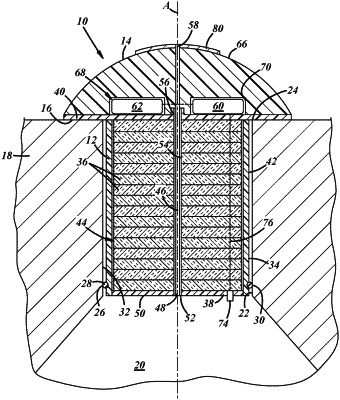| CPC F17C 13/06 (2013.01) [A01N 1/0257 (2013.01); A61M 1/00 (2013.01); F17C 13/001 (2013.01); F17C 13/026 (2013.01); F17C 2205/0311 (2013.01); F17C 2205/0338 (2013.01); F17C 2223/0161 (2013.01); F17C 2250/0439 (2013.01); F17C 2250/0478 (2013.01); F17C 2250/0491 (2013.01)] | 17 Claims |

|
1. A closure for a cryogenic storage container having a storage cavity and a neck extending from the storage cavity to an open end, the closure comprising:
a body;
a shoulder;
a head removably joined with the body at the shoulder, the body extending from the shoulder to a free end and having a hollow portion between the shoulder and the free end, the head extending from the shoulder in a direction away from the free end of the body;
a cavity defined between the head and the body;
at least one electronic device located in the cavity between the head and the body, the at least one electronic device being configured to provide information pertinent to a condition of the storage container in which the closure is removably installed, wherein said condition includes at least one of: a global position, a container identifier, a storage cavity temperature, an orientation, an elapsed time, an open or closed state, or a history of any of the preceding conditions;
a sealing surface located along and circumscribing the body, the sealing surface being configured to form a fluid-tight seal with the neck of the container when the closure is in an installed position with the shoulder at the open end of the neck, the fluid-tight seal being continuous about an entirety of the sealing surface to form a closed circumscription about the entirety of the sealing surface;
an aerogel material enclosed in the hollow portion of the body; and
a vent having a first open end at the free end of the body and extending through the body from the first open end to a second open end, the first and second open ends being on opposite sides of the hollow portion of the body,
wherein the aerogel material has an opening formed therethrough and the vent passes through the opening so that, when the closure is in the installed position, the storage cavity is fluidly connected to an environment outside of the storage container.
|
|
5. A closure for a cryogenic storage container having a storage cavity and a neck extending from the storage cavity to an open end, the closure comprising:
a body;
a shoulder;
a head removably joined with the body at the shoulder, the body extending from the shoulder to a free end and having a hollow portion between the shoulder and the free end, the head extending from the shoulder in a direction away from the free end of the body;
a cavity defined between the head and the body;
at least one electronic device located in the cavity between the head and the body, the at least one electronic device being configured to provide information pertinent to a condition of the storage container in which the closure is removably installed, wherein said condition includes at least one of: a global position, a container identifier, a storage cavity temperature, an orientation, an elapsed time, an open or closed state, or a history of any of the preceding conditions;
a sealing surface located along and circumscribing the body, the sealing surface being configured to form a fluid-tight seal with the neck of the container when the closure is in an installed position with the shoulder at the open end of the neck;
an aerogel material enclosed in the hollow portion of the body; and
a vent having a first open end at the free end of the body and extending through the body from the first open end to a second open end, the first and second open ends being on opposite sides of the hollow portion of the body,
wherein the aerogel material has an opening formed therethrough and the vent passes through the opening so that, when the closure is in the installed position, the storage cavity is fluidly connected to an environment outside of the storage container.
|